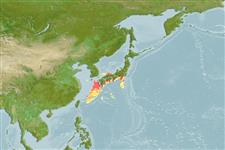Environment: milieu / climate zone / depth range / distribution range
Ecology
Marine; bathydemersal; non-migratory; depth range 300 - 1000 m (Ref. 1371). Deep-water; 36°N - 20°N, 125°E - 140°E (Ref. 1371)
Northwest Pacific: southern Japan (Ref. 1371) and Taiwan (Ref. 54421). Possibly much wider in distribution.
Size / Weight / Age
Maturity: Lm ? range ? - ? cm
Max length : 75.0 cm TL male/unsexed; (Ref. 1371)
Dorsal spines (total): 2; Anal spines: 0. Eyes very large; snout long, sharply pointed, its anterolateral margin completely supported by bone; head ridges prominently demarcated by stout, spiny scales; underside of head scaled. Light organ short. Overall color is grayish to brownish, without prominent markings; mouth cavity gray; gill cavities and distal third of the first dorsal fin blackish.
Larger individuals are found in deeper waters. Feeds on euphausiids, prawns, benthic fishes, isopods, and polychaetes.
Life cycle and mating behavior
Maturity | Reproduction | Spawning | Eggs | Fecundity | Larvae
Cohen, D.M., T. Inada, T. Iwamoto and N. Scialabba, 1990. FAO species catalogue. Vol. 10. Gadiform fishes of the world (Order Gadiformes). An annotated and illustrated catalogue of cods, hakes, grenadiers and other gadiform fishes known to date. FAO Fish. Synop. 125(10). Rome: FAO. 442 p. (Ref. 1371)
IUCN Red List Status (Ref. 130435: Version 2024-2)
Threat to humans
Harmless
Human uses
Fisheries: minor commercial
Tools
Special reports
Download XML
Internet sources
Estimates based on models
Preferred temperature (Ref.
123201): 7.2 - 13.7, mean 10.3 °C (based on 19 cells).
Phylogenetic diversity index (Ref.
82804): PD
50 = 0.5000 [Uniqueness, from 0.5 = low to 2.0 = high].
Bayesian length-weight: a=0.00245 (0.00126 - 0.00477), b=3.19 (3.02 - 3.36), in cm total length, based on LWR estimates for this Genus-body shape (Ref.
93245).
Trophic level (Ref.
69278): 3.5 ±0.52 se; based on food items.
Resilience (Ref.
120179): Very Low, minimum population doubling time more than 14 years (Preliminary K or Fecundity.).
Fishing Vulnerability (Ref.
59153): Moderate to high vulnerability (50 of 100).
